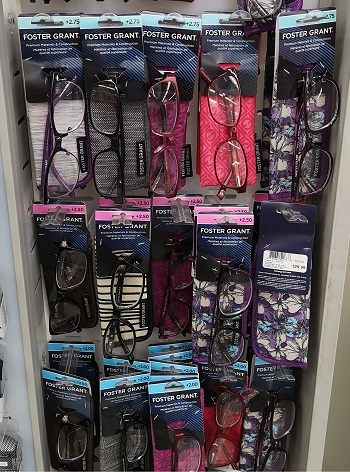 Have you noticed that your eyes aren’t as good at seeing up close as they use to?
Have you noticed that your eyes aren’t as good at seeing up close as they use to?
It usually starts in the late 30s, early 40s with difficulty reading fine print but as time goes on it just keeps getting worse. Don’t worry, this is due to a normal process called presbyopia.
You know that you need reading glasses, but what’s the right strength of reading glasses for you?
It goes without saying that the best strength of reading glasses for you is the prescription for reading glasses that your eye doctor has given you.
However, you may find yourself in a situation when you are unable to acquire prescription glasses but you still need something to help you out.
This article will discuss the use of over-the-counter reading glasses, also known as ‘cheaters’, off-the-shelf reading glasses or drugstore reading glasses. These can be obtained without a prescription, but you’re left to figure out what ‘strength’ or ‘power’ you need on your own. So how do you determine the strength of reading glasses that you need?
Grab your most recent eyeglass prescription and carefully read through this article to find out. Now, let’s get started!
The Strength of Reading Glasses – Start With Your Prescription
Interpreting glasses prescriptions can be very tricky if you’re not familiar with how they are written. I will be as thorough as I can here but for more information on this you can read the article I wrote entitled How To Read Glasses Prescription.
The first thing to do would be to determine if you have a prescription for distance glasses, reading glasses, or both.
This will usually be indicated somewhere on the prescription. Generally speaking, whether a prescription is for reading glasses, distance glasses or both (bifocal/progressive glasses) is either written out in the remarks section of your prescription, or it is indicated on a checklist of lens options.
Here are two common ways to indicate that a prescription is for reading glasses only.
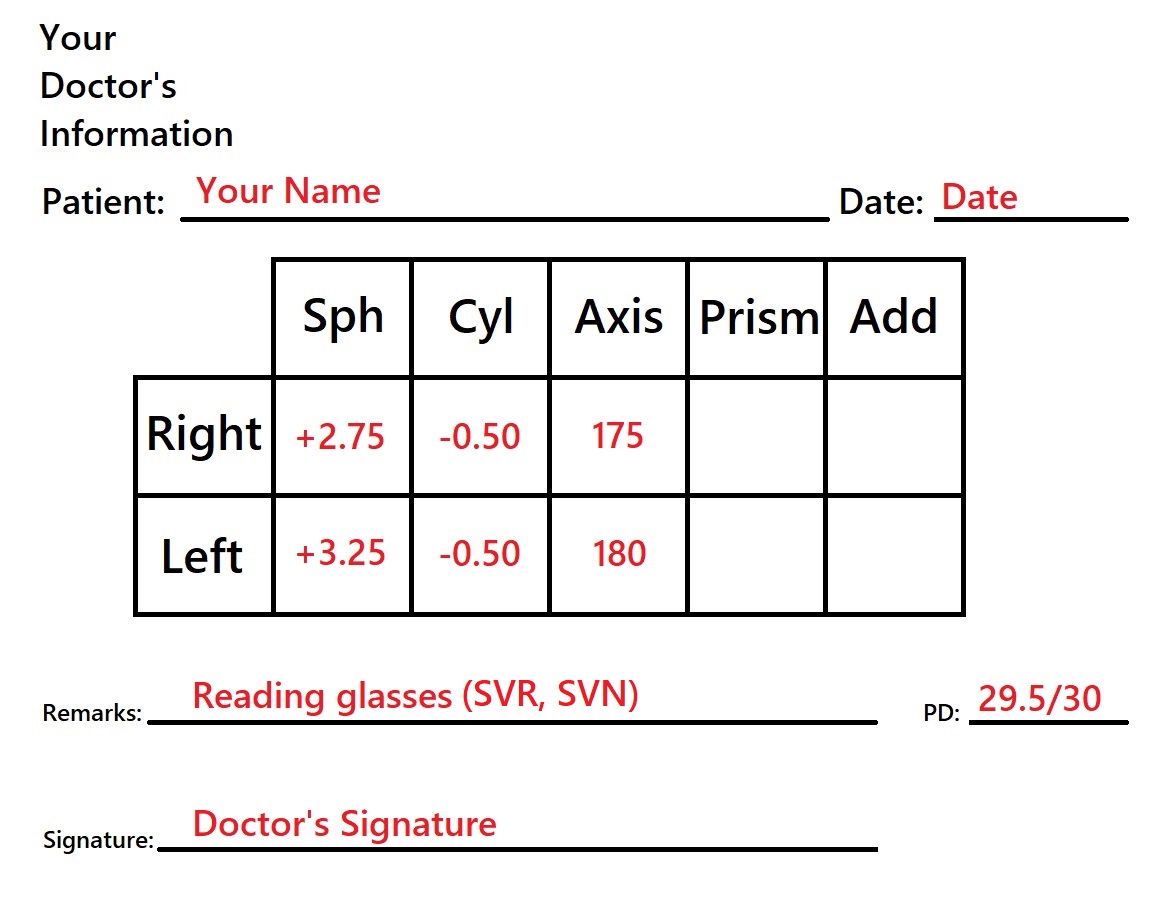 |
 |
Note here that the terms ‘reading glasses’, ‘single vision reading’, ‘single vision near’, ‘SVR’ and ‘SVN’ are all interchangeable terms and mean the same thing.
Your prescription is likely to be written this way if your eye doctor feels like you need glasses for reading but not for distance viewing.
Alternatively, if your eye doctor has determined that you need separate glasses for distance viewing as well as for reading, you may have a prescription that looks more like this.
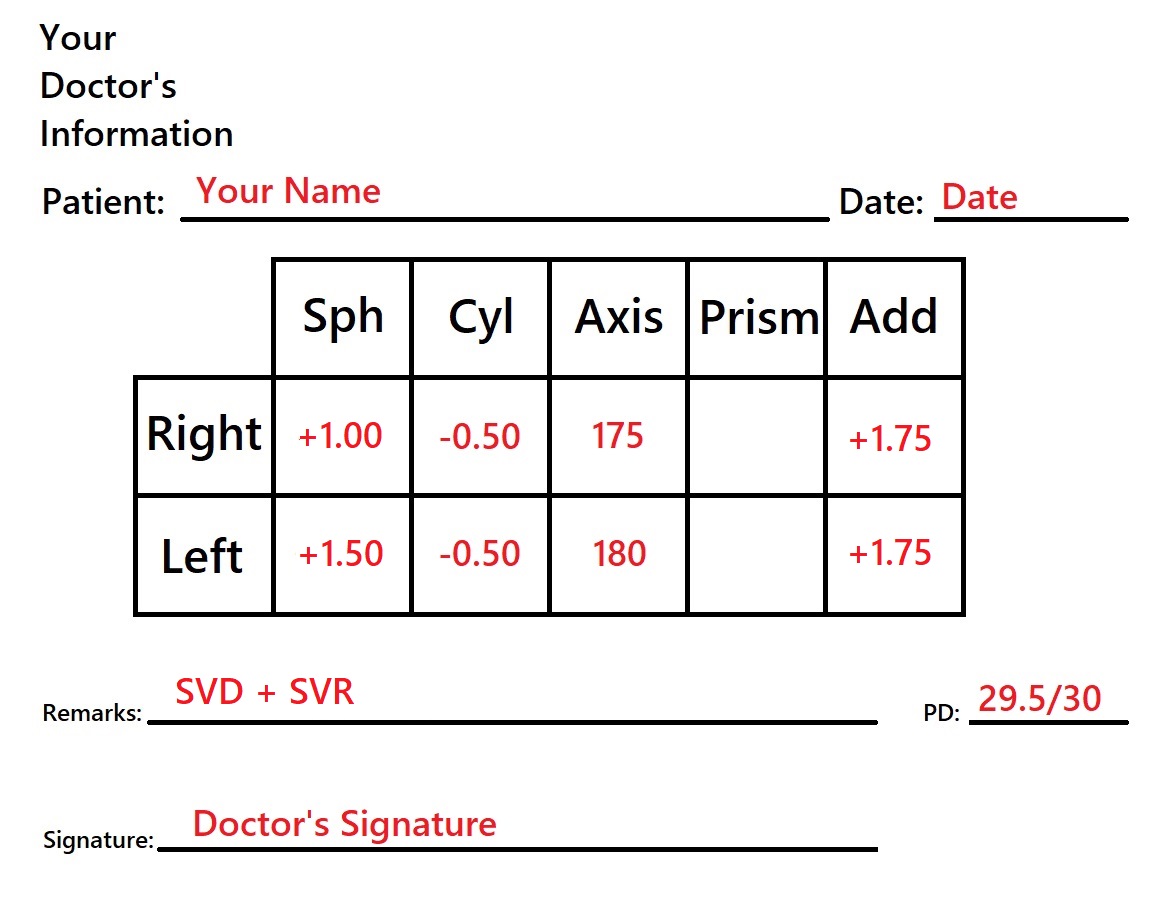 |
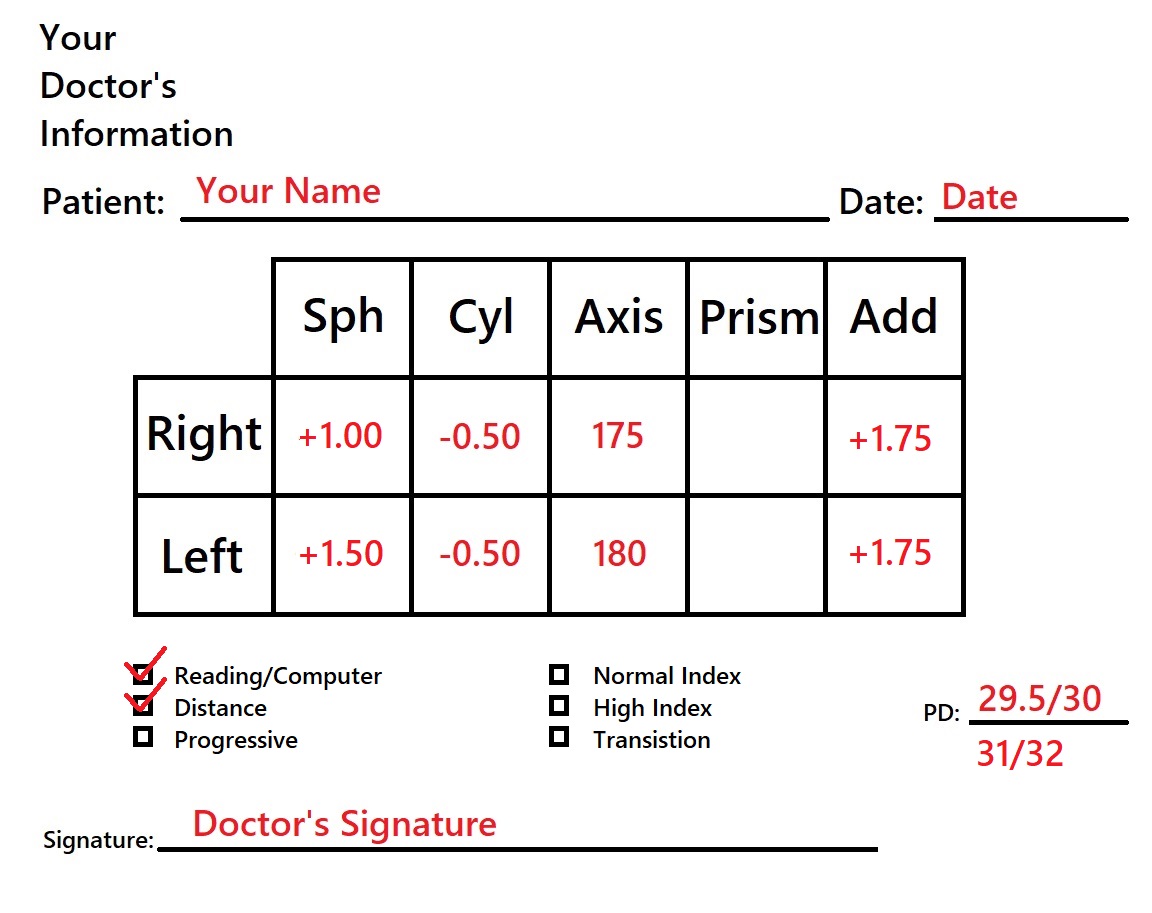 |
Note here that terms ‘distance glasses’, ‘single vision distance’, ‘SVD’ are all interchangeable and mean the same thing.
Lastly if you have a prescription for bifocal/progressive glasses, your prescription might look something like this.
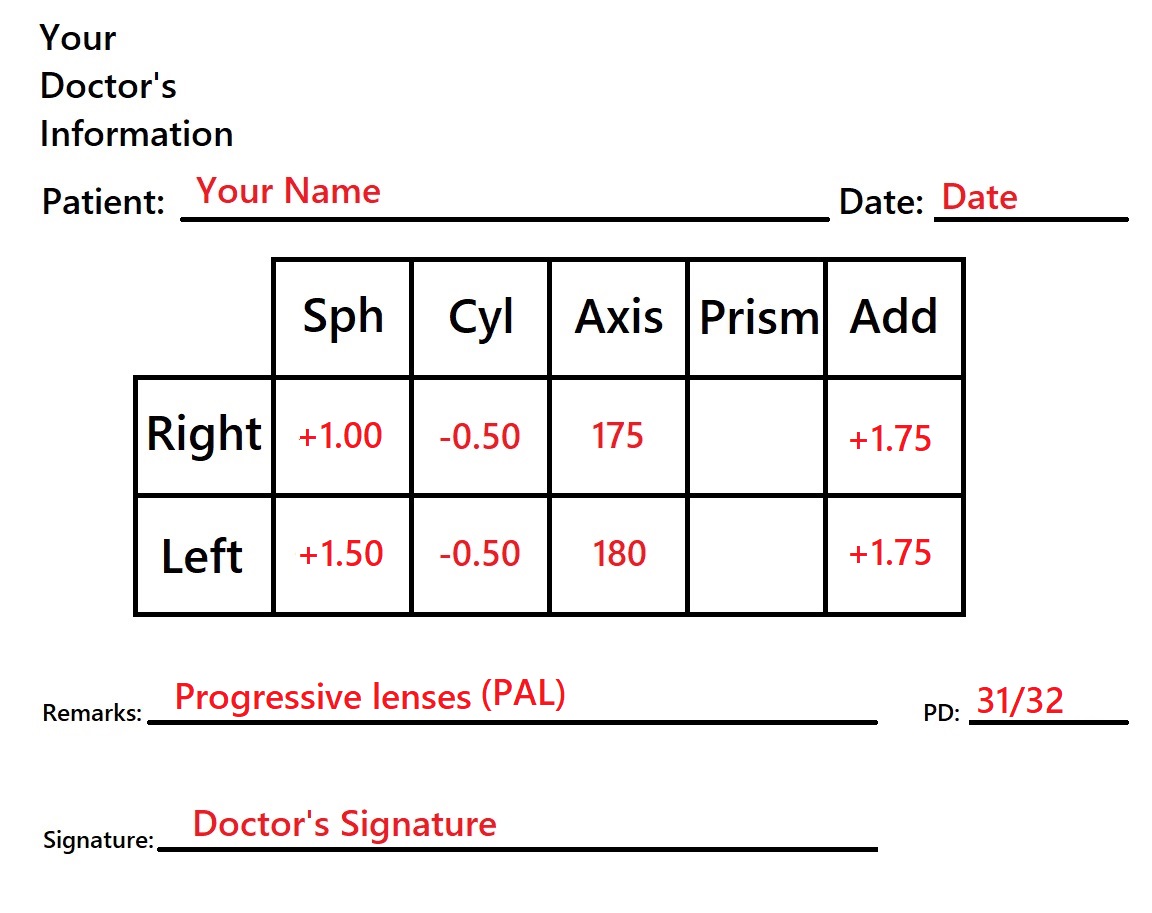 |
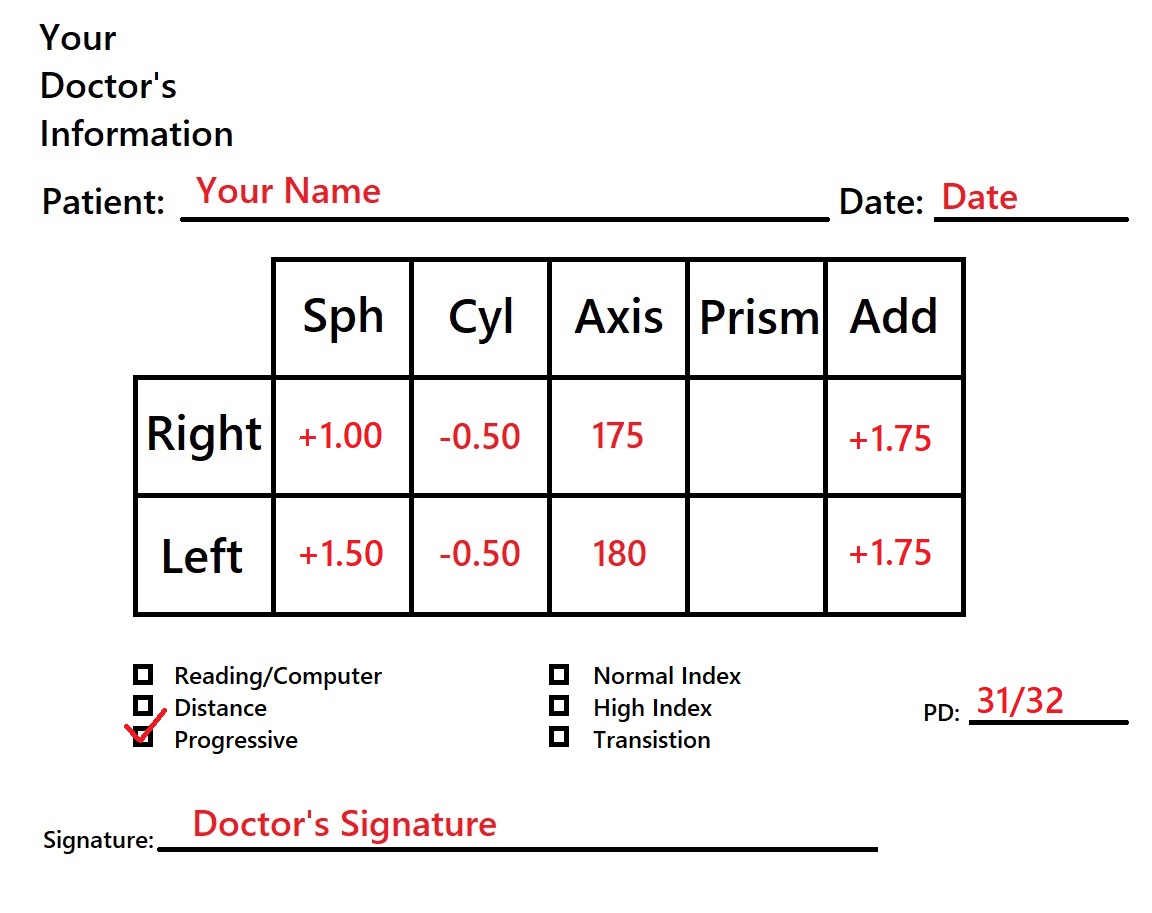 |
Note that the term ‘progressive’ and ‘PAL’ (progressive addition lenses) can be used interchangeably.
If you’ve identified your glasses prescription to be specifically for reading glasses, you can skip to the section titled Calculating the Spherical Equivalent of Your Glasses Prescription.
However, if your prescription has been written for both distance and reading glasses, or for progressive glasses – in other words, if you have any numbers under the ‘ADD’ section, you will have to calculate your reading prescription.
But don’t worry, it’s not difficult and I’ll show you how, just keep reading!
Calculating The Strength of Your Reading Prescription
What we’re doing here is using the information provided on your prescription to determine the strength of your reading prescription.
It is common to mistake the number in the ‘ADD’ column as what the strength of your reading glasses should be, but for the vast majority of people, it is not. In fact, for most people it’s not even close and will make your vision a lot worse!
In order to find the correct strength of your reading glasses, you have to add the ‘ADD’ number and the ‘SPHERE’ number together for each eye.
Note: Be very careful about the signs! The ‘SPHERE’ number will either have + or – sign in front of it. The ‘ADD’ number will always have a + sign in front of it. When adding the two together, make sure you are comfortable with adding positive and negative numbers together if it’s necessary.
In this example prescription, the calculations would look like this.
Right Eye
‘SPHERE’ is +1.00
‘ADD’ is +1.75
Strength of reading glasses is +1.00 + 1.75 = +2.75
Left Eye
‘SPHERE’ is +1.50
‘ADD’ is +1.75
Strength of reading glasses is +1.50 + 1.75 = +3.25
Don’t Forget the Cylinder and the Axis!
Your prescription may or may not have any numbers in the ‘CYLINDER’, ‘AXIS’ and ‘PRISM’ columns. If any numbers are present here, they remain unchanged and are still part of your prescription for reading glasses. Let’s look at another example. Suppose these are the numbers on your prescription.
| Eye | SPHERE | CYLINDER | AXIS | ADD |
| Right | -4.50 | -1.50 | 165 | +2.50 |
| Left | -1.00 | -1.00 | 075 | +2.50 |
The strength of the reading prescription would be:
| Eye | SPHERE | CYLINDER | AXIS | ADD |
| Right | -2.50 | -1.50 | 165 | |
| Left | +1.50 | -1.00 | 075 |
We got to these numbers by adding the ‘ADD’ number to the ‘SPHERE’ number for each eye and keeping the ‘CYLINDER’ and ‘AXIS’ the same. The calculations went as follows:
For the right eye: +2.50 + (-4.50) = -2.00
For the left eye: +2.50 + (-1.00) = +1.50
If you still have questions about this part, feel free to ask me in the comments section of this article.
Calculating the Spherical Equivalent of Your Glasses Prescription
Now that we know the reading prescription, we have to deal with the ‘CYLINDER’ and the ‘AXIS’ number. These numbers represent how much astigmatism correction is in your prescription.
Over-the-counter reading glasses never contain any astigmatism correction. That is why we want to boil the reading prescription down to a single number. This is called taking the ‘equivalent sphere’ of the prescription.
For a lengthier discussion of how to calculate the ‘equivalent sphere’, you can read the article I wrote on the topic entitled The Spherical Equivalent of Your Prescription.
If you do not see any numbers in the ‘CYLINDER’ and ‘AXIS’ columns in your prescription, you are done with this step and skip to the next section entitled Accounting for Differences Between Eyes.
Similarly, if you see the number -0.25 in the ‘CYLINDER’ column for either eye, you do not have to perform any calculations. A -0.25 in the ‘CYLINDER’ column is not strong enough to affect the ‘equivalent sphere’ and it is just dropped from the prescription along with the ‘AXIS’ for that eye. So if both eyes have -0.25 in the ‘CYLINDER’ then continue to Accounting for Differences Between Eyes.
However, if the number in the ‘CYLINDER’ column is -0.50 or anything higher than that, a calculation needs to be performed. To calculate the ‘equivalent sphere’ (ES), follow this formula:
ES = ½(CYLINDER) + SPHERE
Note: ‘CYLINDER’ numbers are always (with some rare exceptions) negative so be mindful of the signs. If you’re not comfortable with equations, following the next few steps will arrive at the same number.
Step 1: Look at the ‘CYLINDER’ number. Does it end with a ‘0’ or a ‘5’? If it ends with a ‘0’, skip to step 3. If it ends with a ‘5’, proceed to step 2. Step 2: Subtract 0.25 from the |CYLINDER| (the absolute value of the ‘CYLINDER’).This means that just for this step, ignore the negative sign in front of the ‘CYLINDER’ number and subtract 0.25 from that number. You should end up with a number that ends in a ‘0’. For example, -2.75 → -2.50, -6.25 → 6.00, etc. Step 3: Divide the ‘CYLINDER’ number by 2. Step 4: Add the number you get from step 3 to the ‘SPHERE’ number.
The number from step 4 is the ‘spherical equivalent’ of the reading prescription.
For the remainder of this article, disregard the ‘CYLINDER’ and ‘AXIS’ numbers.
Note: The ‘CYLINDER’ and ‘AXIS’ numbers are part of glasses prescriptions for a reason. The higher the ‘CYLINDER’ number is, the more important it is to your vision. If the ‘CYLINDER’ number is -1.00 or higher, it is likely that over-the-counter reading glasses will provide vision that is noticeably worse than prescription reading glasses.
Before going forward it’s time to break some bad news to some people. If the ‘spherical equivalent’ number that you’ve calculated is negative, you will not be able to find any over-the-counter reading glasses to help you. Pre-made off-the-shelf reading glasses are only made and sold in ‘positive’ powers. If you prescription for reading glasses is ‘negative’, the only option will be to get prescription reading glasses from your optician.
Accounting for Differences Between Eyes
At this point you should have 1 number for each eye which represents the most ideal strength for over-the-counter reading glasses.
If those two numbers are the same, you are in luck and you can skip to the section entitled Adjusting the Strength of Reading Glasses for Your Working Distance.
However, if the numbers are different, unfortunately some compromise will have to be made. As you’ve most likely noticed when shopping for over-the-counter reading glasses, the number for the right and left eye are always the same.
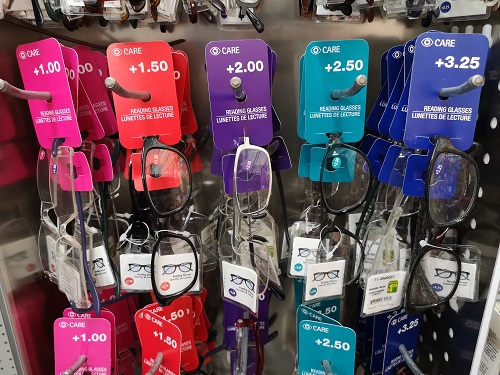
If the strength needed for your right and left eyes are different, which one do you choose?
If the difference between your right and left eye’s number is only 0.25, choosing one or the other typically doesn’t make much difference.
If the difference between your right and left eye’s number is 0.50, splitting the difference usually works.
If the difference between your right and left eye’s number is 0.75 or more, over-the-counter reading glasses may not be the best option for you. To try to make it work, start with the number for your dominant eye, and try every step between that number and the number of your non-dominant eye and look for the one that provides the best visual comfort.
Adjusting the Strength of Reading Glasses for Your Working Distance
The strength of reading glasses determines how far or close you will be able to see with them.
If the power is too low, you will have to hold things further away to see them clearly.
If the power is too high, you will have to hold things closer than usual before it will be clear.
By default, unless specified otherwise on your prescription, eye doctors prescribe reading glasses to maximize vision at 16inch/40cm. If this is the ideal distance for you, then you are done. No further adjustments are necessary.
However, if you feel that 16inch/40cm is too close (as is the case for most computer users), or too far (as is often the case for people with short arms) you will need to adjust the strength one more time.
The correct strength of reading glasses for you will depend on where you need to see clearly (i.e, is it for reading in bed, working on your computer, etc) so measure that distance out, and then refer to the following chart.

Start by finding the number that you ended up with so far in the top row called “If @ 40cm the ADD is:”, then move down that column until you find the row of your desired ideal distance (listed on the left hand side).
Trying it on
Of course, don’t base everything on the theoretical calculations discussed in this article. This should give you a good place to start. The next step would be to head to your favorite retailer of over-the-counter reading glasses and start trying them on.
Start with the number that you ended up with after reading this article. If you feel that the vision needs to be better farther away then reduce the strength.
If you feel that the vision needs to be better closer, then try increasing the strength.
If any part of this article has not been explained clearly or you have additional tips to offer, please let me know in the comments below.




8 Responses
Shirley Dawson
I have a trifocal lens in my current glasses and only use them when reading because the way the lens works drives me crazy trying to figure out how to hold my head when reading or working on my computer. I have an introcoluar “multi-focus point” lens in both eyes and typically I have been using glasses only to read books. Sometimes I just get the Walmart “cheaters” but I never get the right ones. Thanks for this information. -Shirley
Danica
Thank you for this article! I have had to wear glasses since Kindergarten because of farsightedness. My eyes have progressively gotten worse. Every year I go to the eye doctor and periodically they tell me that I may want to consider readers. But I had no idea how to pick a strength and I don’t have the time to try on every strength. This article was very helpful in giving a starting point.
Cathy
This article is fantastic! I’ve been using otc glasses for years, and when I finally got a prescription pair, I saw that I was a ways off. It can sure be difficult finding the right strength just by reading a block of text at the local store. Thank you for publishing this!
Laura
While readers are great, I have astigmatism and they didn’t work for me. So, I switched to a different prescription lens for desk/PC work so I could read items lying on my desk and wall as well as computer documents. It was extremely frustrating not to be able to read things in my cubical when I used info on my desk, walls, PC and rolodex all of the time. So, I use a mid-range (middle vision) ‘script for the top and a reading lens for the bottom (no distance lens). Now, I can see everything at my desk like I did when I wore single vision lenses. Be sure to measure the distance between you and your computer screen when seated at your computer and give it to your eye professional. (My measurement was 16″.) This made all the difference in my remaining productive and happy at work. And I owe it all to one eye professional. Everyone else was clueless.
David
This is very, very helpful and consistent with what I see on some other sites. Thanks!
However, the cylinder correction on my current RX is +75 (a positive, not negative as this article addresses). Given this, how do I compute the Sphere Equivalent?
Thanks very much!
Julie
Hi David, good catch! There are a small minority of eye doctors, usually ophthalmologists, that write glasses prescriptions using ‘plus cylinder’ instead of the usual ‘minus cylinder’. To deal with this, start with reading my article ‘Convert Plus Cylinder To Minus Cylinder’. From there you can apply the advice (non-medical) discussed in this article. Thanks for reading!
Brianna
Had a question about my new perception I got today compared to my old one. My old one (4 years ago) was
OD: Sphere -1.50, Cylinder -.25, Axis 078
OS: -1.50, -.50, 013
PD: 53
New;
OD: -2.0, 0.0, 180
OS: -1.25, 0.0, 180
PD: 59.50/56.50
I tried looking up new glasses with my new perception when I got home but there telling me this new one is impossible. Can you explain why?
Julie
Hi Brianna, good question. Here are my thoughts.
Your old prescription was:
R: -1.50 -0.25 x 078
L: -1.50 -0.50 x 013
And the new one:
R: -2.00 0.00 x 180
L: -1.25 0.00 x 180
As you can see, prescriptions for glasses can contain up to three numbers for each eye. They are called, in order from left to right, the Sphere, Cylinder, and Axis.
Your old prescription has non-zero values in each of these categories, but your new one doesn’t. Your new prescription has zeros in the Cylinder category. When there is no Cylinder in a glasses prescription, it is meaningless to include an Axis. The Axis describes the direction of the Cylinder. So if you try to order glasses with an Axis, but with no Cylinder, you will most likely get an error (as it makes no sense).
My guess is that your prescription was generated by some program that uses ‘180’ as a default when there is no Cylinder. An optician in a brick and mortar store would understand this and ignore the Axis. However, online glasses stores are probably programmed to reject invalid inputs.
Hope that helps!